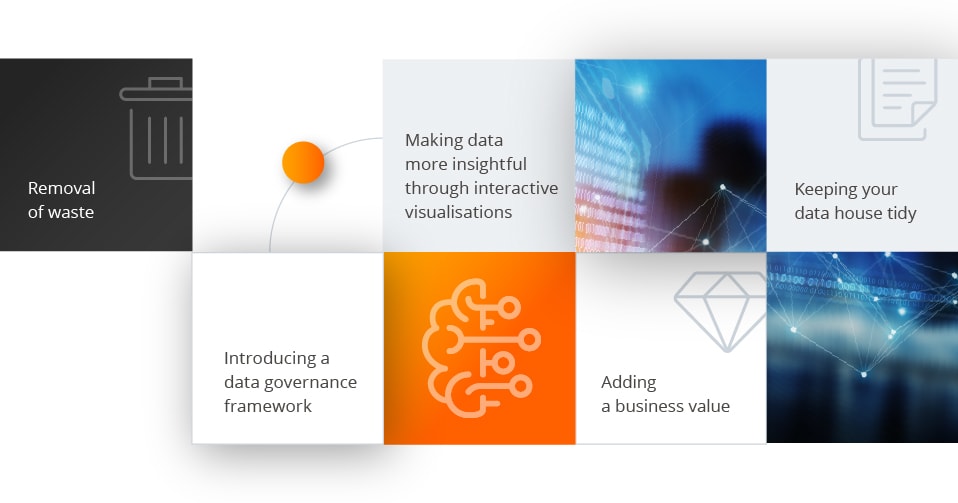
Machine Learning strategy for businesses: a practical guide
It’s been ten years since AlexNet’s success in starting the current deep learning revolution. The dust has already settled, the hype abated, and we are now entering the phase of productivity. What does it mean for you?
Machine Learning strategy: definition
“Machine learning is a branch of artificial intelligence (AI) and computer science which focuses on the use of data and algorithms to imitate the way that humans learn, gradually improving its accuracy.”
That’s an IBM definition. Machine Learning is a complex concept, so before deciding to leverage any ML solutions, it’s wise to take a step back and ask yourself a few questions. Here they are – for your ease we divided them into the basics of ML strategy and the questions that help address the challenge.
The basics of ML strategy for businesses and organisations
Do you have any data to work with? If so, is your data structured or unstructured?
You need to be fully aware of the kind of data that you have in order to know how it should be applied. Structured data is clearly defined, stored in tabular forms and easily searchable (like customer phone numbers or transactional information). Unstructured data is not organised, and is stored in its native format (like audio files or images).Do you understand your data and the processes you want to optimise?
You should be able to separate right from wrong and know which pieces of data are actually relevant to the processes that require optimisation – processes that should also be known inside-out.Does your data storage architecture provide seamless data usage?
You should have convenient yet secure access to data, permitting easy collaboration between data engineers.Have you already reviewed your current reporting system?
Maybe all that you need to begin with is simple analytics instead of complex machine learning applications.
Addressing problems before developing a Machine Learning strategy
Can you identify a business issue that could be solved with the use of enterprise machine learning?
It’s essential to know exactly what you need ML for and the effects that you expect. This will be helpful later on, when the time comes to measure the results of your investment and make any adjustments to your strategy.Do you have sufficient data, or maybe you need some external data sources?
Very often, companies need to reach for public government data or use social media analytics tools to gather more of it. This isn’t exactly rocket science, but it adds another layer to your business and technological process.Are you at a sufficient level of expertise to solve this task? Do you have enough collected data?
Maybe you will need to collaborate with an external Data Solutions partner or outsource data analysis to evoke the full potential of Machine Learning. Plus, a tandem of data and machine learning engineers are often needed in order to implement ML solutions correctly, so you need to take this into consideration as well.Should this be a one-off like a discovery experiment, or a solution that will be repeated?
If it’s the latter case, you will need to think about how to maintain the solution, which can sometimes be trickier and more time and resource-consuming than the Machine Learning algorithm itself.Are you able to build infrastructure for the solution?
This is also an HR-related question. It’s very likely that your IT team is not capable of creating an efficient infrastructure on their own, especially if they have little to no experience with ML.Can you take the risk of failure?
The initial phase of the ML solution is always an experiment. It requires multiple attempts at parameter tuning or making several changes to the original model. Due to the very specific nature of the ML solution development process, one would need to be conscious of the fact that there are situations in which we may not be able to receive a complete answer to our original question, though this doesn’t mean that we can’t still benefit from the insights that we’ll have gathered along the way.
What if you don’t have all the answers?
You might not be able to answer all of the above-mentioned questions. For example, you may not fully comprehend the nature of your processes, lack sufficient data, or not have all of the resources needed to implement a desired ML solution.
But should this hold you back from investing in this kind of technology? Not necessarily.
Nowadays, there are many ways to bridge certain gaps:
If you need to enrich your data, because the pieces that are at your disposal are insufficient, you can turn to external sources. Companies like Google or Facebook offer access to the data they are constantly gathering, and you can either use this as a complementary source or build your own solution on top of their data with the help of an Software Development Company. Of course, this would only apply to a certain group of specific problems.
If your objective for using ML is not well-defined, think about workshop with technical and business experts to understand your data better and identify possible ways to utilise ML in your organisation.
If you don’t have the in-house resources needed to build a solution, there are outsourcing companies with experience, providing either small parts to a solution or entire solutions on their own.
Of course, you may also come to the conclusion that machine learning is not something that you need to implement at this very moment.
Maybe some classic methods in analytics will suffice, but you will still need to learn how to use them more effectively.
A thorough evaluation of your situation is a must, in order to avoid putting all your resources into something that is not going to bring any additional benefits to your business.
The business challenges that ML and deep learning models can address
A key when it comes to the final decision of whether using machine learning strategy lays in understanding the business challenges it can address. Let us give you just some of the very many examples.
Machine learning techniques facilitates predictive analytics. It can analyse historical sales data and external factors to predict future sales, helping businesses optimise inventory and staffing. It can also predict which customers are likely to leave, allowing companies to take proactive retention measures.
An interesting use case of machine leaning is also recommendation systems, and we all know personalised product recommendations can improve cross-selling and upselling in e-commerce.
Natural Language Processing tools are used in chatbots and virtual assistants, as well as in sentiment analysis and language translations, allowing your clients to use your online solutions no matter their location or the language they use.
It is also a great help when it comes to fraud detection – it can be used to identify fraudulent transactions in real-time, reducing financial losses.
In finance, machine learning used in algorithmic trading and credit scoring allows for making data-driven investment decisions and assessing creditworthiness of loan applicants.
Read more about other applications of Machine Learning algorithms:
- Machine Learning in logistics
- How is Natural Language Processing (NLP) used in business?
- NLP techniques: key methods that will improve your analysis
- How to implement predictive maintenance
It’s just the tips of the iceberg – there are so many uses of data driven models in modern business, we probably wouldn’t manage to list them all. But what we’ve listed has probably given you a good picture of business benefits of machine learning techiques.
Two ways of getting your ML solution
When you decide to start your ML journey, there are two ways you can go: you can either buy a ready tool or develop one. Both options carry some risk, both mean costs.
The cheapest way to go about introducing ML to your business is to buy a ready solution.
Even better is to find one on GitHub – there is an abundance of them there! But when using something that already exists, you need to take into consideration that it may not always do exactly what you are after, and it may not be the best option for your organisation.
The second way is to create the ML solution from scratch.
Such an approach means your solution will be tailored to your needs, it will respond to the problems you have, and it will be specific to your organisation. A definite downside here is cost.
Good news is there is a way in the middle, a combination of the two already described. You can find and buy a half-finished product and you can develop it so that it responds to your needs and works exactly as you want it to work. It’s a solution that is being used more and more often – a very pragmatic and cost-effective one.
What do you need to succeed with your ML strategy? 5 steps guide
Now that we’ve established the ways of getting your ML solution, let’s look at what you really need to succeed with your ML strategy. Here is our list:
Step 1. Define clear objectives and goals
It may sound obvious, but to start with, you need to know what problem you want to solve, and you need to be sure solving it will give you a proper value. What’s more, you need to check that the problem is solvable using ML.
To do that, define clear, measurable objectives, such as reducing costs, increasing revenue or improving customer satisfaction. Remember to start with a few well-defined projects rather than trying to tackle everything at one.
Step 2. Data collection and preparation
Data lies at the heart of all organisations and at the centre of all IT projects they undertake. What counts is its quality and quantity, but also the relevance to the problem you want to solve using ML.
Having access to high volumes of data does not necessarily mean it will be valuable for you: weather related data alone is not good enough for problems related to industrial processes, even if the weather influences them directly.
Data collection should start even before the beginning of your ML project: given the always increasing data volumes, it’s worth thinking about your data strategy as soon as possible and assess your current data landscape before you set off on any ML journey.

Step 3. Explore the options to work with the best talents
If you are outsourcing your ML engineers, they will definitely need support from within your organisation: they will need to speak to domain experts who understand the problem they are working on, who are able to explain it properly, and who will be able to evaluate the results provided.
Remember that collaborating with skilled individuals is critical to the success of your ML initiatives. Building a strong ML team and fostering the culture of innovation is of paramount importance.
Step 4. Implementation and integration of Machine Learning model
Choose appropriate ML algorithms and deep learning architectures based on the nature of your data and the specific use case. Consider factors such as classification, regression, clustering, or recommendation. Train your models using a representative dataset. Employ techniques like cross-validation to assess model performance and fine-tune hyperparameters.
Step 5. Evaluation and continuous improvement
Evaluation and continuous improvement of your ML initiatives is absolutely crucial if you want your ML project to remain effective, efficient and aligned with your business goals.
To do that, define Key Performance Indicators, implement a regular evaluation process, get feedback and encourage collaboration and communication among team members, including data scientists, engineers, domain experts and stakeholders.
Also, remember to use iterative development approach – continuously iterate on your ML projects, incorporating feedback and making improvement in each iteration.
Practical use of Machine Learning algorithms
The opportunities offered by Machine Learning were first used by Internet giants processing data from social media and online retail. Soon they were followed by hardware companies, who used it to optimise their chips, memory, and storage.
The recent pandemic forced many businesses around the world to set off on their digital transformation journey or to accelerate what they were already doing. The result is that today many services are delivered almost entirely online via automated or semi-automated processes.
What does it all mean for you? It means it’s time to embrace ML and use it to your advantage!
No matter whether you are keen to add some ML solutions or are ready for a full digital transformation, it is definitely worth investing your time in checking available solutions and their importance for your business processes.
Looking for the right partners for your ML project?
No matter what stage of your ML strategy you are at, Future Processing can help. Let’s look at what we can do for you:
If you are considering a problem to be solved, consult it with our ML specialists: check your options and whether the problem you are thinking about is solvable using Machine Learning model.
If you already have some data, you can show it to us and check the proof of concept. If you don’t have your data as yet, we can help you organise the data acquisition process (data engineering, cloud, data pipelines – these are all our areas of expertise). A good solution is to speak to pragmatic digital transformation consultants such as embracent, ready to deliver the best results for you and provide solutions to the problems you have.
If you are ready to start – here we come! We have a great team of IT professionals with a vast experience in ML projects. The scope of our cooperation will depend on you: we can either develop the ML model, obtain MVP and / or further develop the solution, or we can provide you with a complete solution including programming, testing, delivery, and maintenance of the application.




